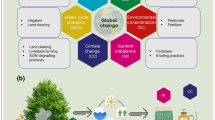Abstract
We conduct an online survey experiment to determine the influence of multifunctionality recognition in agriculture on the price premiums of environmental-friendly agricultural products. We use the case of fish-friendly rice produced in Shiga prefecture, Japan, which contributes to the conservation of the water and ecosystem in rural areas around Lake Biwa by setting up fish ways and reducing the use of herbicides. We assume two conditions for consumers to pay premiums on environmental-friendly agricultural products. The first is that consumers recognize multifunctionality in agriculture. The second condition is that consumers have a correct understanding of environment-friendly agricultural products. We thus examine the effects of respondents’ attributes on their responses to two types of visual stimuli: one associated with the multifunctionality of agriculture and information about environment-friendly agricultural products. In the analysis of the respondents; willingness to pay, the price premium of the group with both the stimulus and information is significantly higher than the price premium of the control group with no interventions. However, the price premium of the group with only the stimulus is not statistically different for the control group. The policy implication of this research is that consumers are more likely to support agri-environmental policies if they recognize both the multifunctionality of agriculture and the properties of environmental-friendly agricultural products. The two types of stimuli have complimentary effects on increasing price premiums. Promoting the recognition of multifunctionality is especially important for those who do not usually access information on agriculture.



Similar content being viewed by others
References
Anderson, Kym, and Yujiro Hayami. 1986. The political economy of agricultural protection: East Asia in international perspective. London and Sydney: Allen and Unwin.
Boush, David M., Marian Friestad, and Peter Wright. 2009. Deception in the marketplace: The psychology of deceptive persuasion and consumer self-protection. New York: Routledge.
Bray, Jeffery, Nick Johns, and David Kilburn. 2011. An exploratory study into the factors impeding ethical consumption. Journal of Business Ethics 98: 597–608.
Hanemann, Michael, John Loomis, and Barbara Kanninen. 1991. Statistical efficiency of double-bounded dichotomous choice contingent valuation. American Journal of Agricultural Economics 73: 1255–1263.
Honma, Masayoashi, and Yujiro Hayami. 1986. Determinants of agricultural protection levels: An econometric approach. In The political economy of agricultural protection: East Asia in international perspective, ed. K. Anderson and Y. Hayami. London and Sydney: Allen and Unwin.
Lee, Angela Y. 2002. Effects of implicit memory on memory-based versus stimulus-based brand choice. Journal of Marketing Research 39: 440–454.
Lopez-Feldman, Alejandro. 2010. DOUBLEB: Stata module to compute contingent valuation using double-bounded dichotomous choice. Statistical software components S457168, Boston College Department of Economics, revised October 14, 2013.
Naoi, Megumi, and Ikuo Kume. 2011. Explaining mass support for agricultural protectionism: Evidence from a survey experiment during the global recession. International Organization 65: 771–795.
Nishimura, Takeshi, Kyohei Matsushita, and Takeshi Fujie. 2012. Seitaikei kankyo hozengata nosanbutsu no kakaku premium no kettei yoin (The determining factors for the price premium of environmentally friendly agricultural products). The Journal of the Society of Environmental Science 25: 204–214.
Ujiie, Kiyokazu. 2014. Consumer preferences and willingness to pay for eco-labeled rice: A choice experiment approach to evaluation of Toki-friendly rice consumption. In Social-ecological restoration in paddy-dominated landscapes, ed. Nisikawa Usio and Tadashi Miyashita, 263–279. Tokyo: Springer.
Author information
Authors and Affiliations
Corresponding author
Ethics declarations
Conflict of Interest
The authors declare no conflict of interest.
Additional information
Publisher’s Note
Springer Nature remains neutral with regard to jurisdictional claims in published maps and institutional affiliations.
Rights and permissions
About this article
Cite this article
Chang, T., Takahashi, D. & Shobayashi, M. Consumers’ Recognition of Multifunctionality in Agriculture and Price Premiums for Environmentally Friendly Agricultural Products: Evidence from a Survey Experiment. Food ethics 2, 111–125 (2019). https://doi.org/10.1007/s41055-019-00033-9
Accepted:
Published:
Issue Date:
DOI: https://doi.org/10.1007/s41055-019-00033-9




